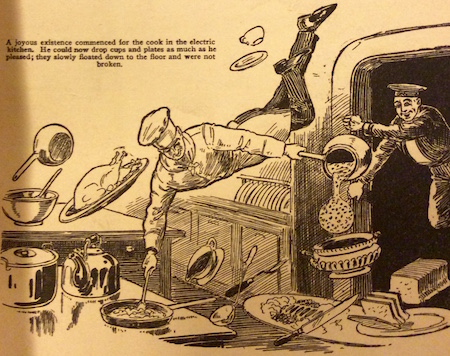Science Fiction
Dictionary
A B C D E F G H I J K L M N O P Q R S T U V W X Y Z
Space Station Kitchens 1929 and 2015

Recently, International Space Station astronauts and cosmonauts revealed some of their kitchen secrets and preferences.
(ISS Kitchen tour at 7'15")
On Monday, Russian cosmonauts surprised their mission control when they requested 15 packages of mayonnaise to be sent in the upcoming shipment of food to the International Space Station (ISS) instead of lemons and tomatoes.Italian astronaut Samantha Cristoforetti brought an espresso with her to the International Space Station (ISS) in November 2014. American astronaut John Young, who later went to the Moon, challenged some safety protocols when he ate a corned beef sandwich that he snuck in to orbit in 1965.
However, nothing can beat Canadian Astronaut Chris Hadfield's space kitchen aboard the ISS, which he used to prepare burritos, gourmet pasta and whatever else he could get his hands on with Mythbusters' Adam and Jamie guiding his mission from Houston.
I thought that this material (along with the floating astronaut video) formed an interesting contrast to a very early prediction of a space kitchen. In his 1929 classic The Shot Into Infinity, Otto Willi Gail gave some thought to the idea of cooking in space.

(The Electric Kitchen [1929])
All objects lost weight, apparently. Limbs became free and light, while there was no alteration in the muscular power which was attuned to terrestrial conditions.... A joyous condition commenced for the cook in the electric kitchen. He could now drop plates and cups as much as he pleased; they slowly floated down to the floor and were not broken.
(Read more about Otto Willi Gail's electric kitchen)
Via SpaceDaily.
Scroll down for more stories in the same category. (Story submitted 2/22/2015)
Follow this kind of news @Technovelgy.| Email | RSS | Blog It | Stumble | del.icio.us | Digg | Reddit |
Would
you like to contribute a story tip?
It's easy:
Get the URL of the story, and the related sf author, and add
it here.
Comment/Join discussion ( 0 )
Related News Stories - (" Space Tech ")
Will Space Stations Have Large Interior Spaces Again?
'They filed clumsily into the battleroom, like children in a swimming pool for the first time, clinging to the handholds along the side.' - Orson Scott Card, 1985.
Reflect Orbital Offers 'Sunlight on Demand' And Light Pollution
'I don't have to tell you about the seven two-mile-diameter orbital mirrors...'
Chrysalis Generation Ship to Alpha Centauri
'This was their world, their planet —
this swift-traveling, yet seemingly moveless vessel.' - Nat Schachner, 1934
The First Space Warship For Space Force
'Each of the electrical ships carried about twenty men...' - Garrett P. Serviss, 1898.
Technovelgy (that's tech-novel-gee!) is devoted to the creative science inventions and ideas of sf authors. Look for the Invention Category that interests you, the Glossary, the Invention Timeline, or see what's New.
Science Fiction
Timeline
1600-1899
1900-1939
1940's 1950's
1960's 1970's
1980's 1990's
2000's 2010's
Current News
The Zapata Air Scooter Would Be Great In A Science Fiction Story
'Betty's slapdash style.'
Thermostabilized Wet Meat Product (NASA Prototype)
There are no orbiting Michelin stars. Yet.
Could Crystal Batteries Generate Power For Centuries?
'Power could be compressed thus into an inch-square cube of what looked like blue-white ice'
India Ponders Always-On Smartphone Location Tracking
'It is necessary... for your own protection.'
Amazon Will Send You Heinlein's Knockdown Cabin
'It's so light that you can set it up in five minutes by yourself...'
Is It Time To Forbid Human Driving?
'Heavy penalties... were to be applied to any one found driving manually-controlled machines.'
Replace The Smartphone With A Connected Edge Node For AI Inference
'Buy a Little Dingbat... electropen, wrist watch, pocketphone, pocket radio, billfold ... all in one.'
Artificial Skin For Robots Is Coming Right Along
'... an elastic, tinted material that had all the feel and appearance of human flesh and epidermis.'
Robot Guard Dog On Duty
I might also be thinking of K-9 from Doctor Who.
Wearable Artificial Fabric Muscles
'It is remarkable that the long leverages of their machines are in most cases actuated by a sort of sham musculature...'
BrainBridge Concept Transplant Of Human Head Proposed
'Briquet’s head seemed to think that to find and attach a new body to her head was as easy as to fit and sew a new dress.'
Google's Nano Banana Pro Presents Handwritten Math Solutions
'...copy was turned out in a charming and entirely feminine handwriting.'
Edible Meat-Like Fungus Like Barbara Hambly's Slunch?
'It was almost unheard of for slunch to spread that fast...'
Sunday Robotics 'Memo' Bot Has Unique Training Glove
'He then started hand movements of definite pattern...'
Woman Marries Computer, Vonnegut's Dream Comes True
'Men are made of protoplasm... Lasts forever.'
Natural Gait With Prosthetic Connected To Nervous System
'The leg was to function, in a way, as a servo-mechanism operated by Larry’s brain...'
